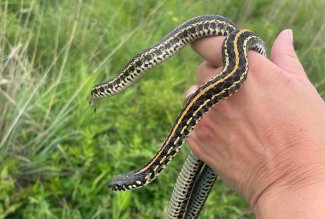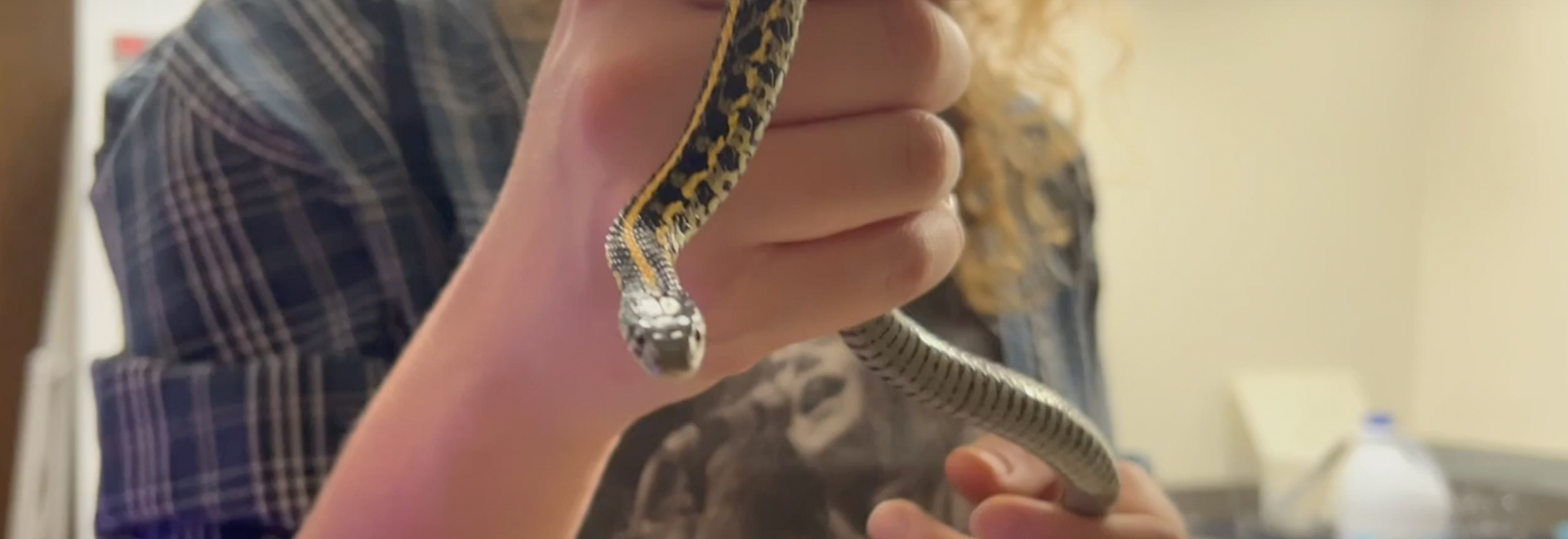
An abrupt U-turn happened this summer when Ohio Northern University biology professor Katheryn Krynak, Ph.D., was taking a road trip during one of her rare days off work. The reason: Momma Snake was giving birth.
Granted, a snake in labor isn’t usually cause for such a sudden change in human plans, but in this case, the snake in question is a member of a species that’s been listed as endangered in Ohio since 1974. In fact, the only Plains Garter Snake colonies that live in the wild in the Buckeye State are located at Kildeer Plains Wildlife Area (KPWA) in Wyandot and Marion counties.
Ohio’s captive Plains Garter Snakes, which are part of breeding programs to increase the population, reside at the Columbus Zoo, where the species’ first captive breeding program began in 1999; at Cleveland Metroparks Zoo; and now at Ohio Northern University.
With licensing from and coordination with the Ohio Department of Natural Resources, and with funding from the Getty College Opportunity Grant and endowed chair dollars, ONU’s Thamnophis radix Captive Breeding Program was established in May with three male snakes and one hefty female, whom Krynak hoped was already pregnant (hence the heft) but wasn’t sure until she got the phone call.
Momma Snake, on the younger side going by size, had a total of 10 babies. This species is ovoviporous, says Krynak, meaning, the females carry and hatch fertilized eggs inside their bodies.
The little ones, along with Momma Snake and the three males, are housed at a campus location with restricted access. The babies are enjoying their own nylon-covered containers, where they are cozied up in moss and other natural habitat materials. For the youngest snakes’ first meals, Krynak and some of her summer biology students fed them earth worms and other goodies. “We may rub some tadpole goo” on said goodies to entice the babies to eat, said Krynak just after they were born.
When conditions are favorable, Krynak will release the babies at KPWA in coordination with the zoos and herpetologist Doug Wynn. Wynn, a world-renowned snake researcher, has been monitoring the snakes at KPWA since the late 1970s and the population will continue to be monitored and studied. Captured adult Eastern Plains garters are assigned a number, tagged with a device the size of a grain of rice placed under the skin, and released or kept for breeding. Babies are also marked with a wire tag and released.
Snake Charmers
“They’re doing well here so far,” said Krynak while holding a lively male snake, his species distinguished by physical characteristics such as a light orange stripe running along his back. “Here in Ohio, the species has an orangier stripe, and they’re different than other garters, with the placement of yellow stripes on their sides. They also have vertical black bars on their lip scales,” she explained. “The striping along the back and sides helps them avoid predators by creating an optical illusion when they move swiftly, messing with the predator’s depth perception. They think they have the snake within their grasp when they actually do not.”
Krynak also notes that in her experience, the Plains Garter Snake is typically docile and shy. “She will flee instead of stand her ground if scared,” says Krynak. In captivity, with familiar handlers, it becomes evident that “they all have their own personalities,” she says.
Their charm, however, hasn’t protected them. According to Krynak, two primary culprits are to blame for Ohio’s decimated Plains Garter Snake numbers: habitat loss and, more recently, a fungal pathogen. These snakes inhabit wetland meadows, many of which have long been transformed into agricultural land. Additionally, fungal pathogens are a global concern for a wide variety of species such as amphibians, bats, and snakes, and climate change may be exacerbating the problem.
Some other factors that have been negatively impacting the species include particular land management strategies such as controlled burns and mowing, practices that have been altered at KPWA.
As a molecular ecologist, Krynak will test snakes in ONU’s breeding project for the fungus, and assist the participating zoos in testing their animals as well. Test results will help with quarantine and potentially medical treatment decisions.
Student Research
This fall, Krynak is being assisted in her snake-saving work by three enthusiastic students majoring in environmental and field biology: senior Haley Goehring senior Greg Brown and sophomore Joseph Lepard.
Goehring, from Cambridge, Ohio, is responsible for snake care and for parasite screenings. “Examining parasites that the snakes may have helps to ensure that we keep them healthy for their release,” she says, adding she thinks this work will make her a more competitive candidate for graduate school and future jobs; her interest lean toward working with and researching wildlife, particularly amphibians and reptiles.
Goehring’s excitement about her snake work is evident. “I have developed a passion for herpetology in recent years and I especially love snakes!” she says. “Garter snakes have so much personality while remaining relatively docile snakes, so I think they are a great introduction to the snake research world.”
The importance of nature conservation is also top of mind for Goehring. “With so many species becoming extinct it is crucial to preserve our native plants and animals for their own sake and for the sake of the environment as a whole,” she says. “The environment relies on the complex and incredibly intertwined interactions between all organisms to function properly, so it is incredibly important to preserve our native biodiversity.”
Lepard, from Grove City, Ohio, is conducting molecular research for the project to investigate the fungal pathogen. “I’m interested in snakes and curious to learn molecular techniques” that he hopes will help the Plains Garter Snake population recover.
Lepard’s hands-on experience with this work will hopefully land him a career one day in biological and/or environmental consulting.
Brown, from Woodville, Ohio, isn’t working directly with the snakes in the captive breeding program, but is surveying snakes at ONU’s Tidd-Oakes Farm for snake fungal disease, the same one that is affecting the endangered species in question. He gained experience working with snakes via outdoor labs and during a summer internship where he worked with a group of biologists conducting snake surveys in New Mexico.
For the captive breeding program, Brown will also be helping to write a grant proposal to acquire equipment for quantifying fungal abundance in the snakes, and is collaborating with the team to develop short video segments to share the ONU team’s research with the public.
“I’m always excited to get to work with snakes!” says Brown, who hopes to become a wildlife biologist working with reptiles and amphibians. And, this program in particular has benefits beyond species conservation. “Humans are dependent on healthy ecosystems with a diversity of organisms. By conserving this threatened species, we are preserving organisms and ecosystems that we rely on,” he points out.
